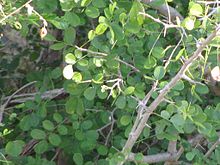Dalbergia melanoxylon
| African blackwood | |
|---|---|

| |
| Scientific classification | |
| Kingdom: | Plantae |
| Clade: | Tracheophytes |
| Clade: | Angiosperms |
| Clade: | Eudicots |
| Clade: | Rosids |
| Order: | Fabales |
| Family: | Fabaceae |
| Subfamily: | Faboideae |
| Genus: | Dalbergia |
| Species: | D. melanoxylon
|
| Binomial name | |
| Dalbergia melanoxylon | |
| Synonyms[2] | |
| |
Dalbergia melanoxylon (African blackwood, grenadilla, or mpingo) in french Granadille d'Afrique is a
African blackwood is a small
Uses

The dense, lustrous
Due to overuse, the mpingo tree is severely threatened in Kenya and is needing attention in Tanzania and Mozambique. The trees are being harvested at an unsustainable rate, partly because of illegal smuggling of the wood into Kenya, but also because the tree takes upwards of 60 years to mature.
African blackwood is often cited as one of the most expensive woods in the world, along with sandalwood, pink ivory, agarwood and ebony.[5][6]
Relation to other woods
- African blackwood is no longer regarded as ebony, a name now reserved for a limited number of timbers yielded by the genus Diospyros; these are more of a matte appearance and are more brittle.
- The genus Brazilian rosewood (Dalbergia nigra), Dalbergia cearensis, cocobolo(Dalbergia retusa) and several others.
Names
Other names by which the tree is known include babanus and grenadilla, which appear as loanwords in various local English dialects.
Conservation
There are multiple organisations involved in the conservation of African blackwood: the Mpingo Conservation & Development Initiative, the African Blackwood Conservation Project, and Daraja Music Initiative (formerly Clarinets for Conservation).
The Mpingo Conservation & Development Initiative (MCDI, formerly the Mpingo Conservation Project) is involved in research, awareness raising and practical conservation of African blackwood. Conservation of mpingo and its natural habitat can be achieved by ensuring that local people living in mpingo harvesting areas receive a fair share of the revenue created, thus providing them with an incentive to manage the habitat in an environmentally friendly manner. In order to achieve this, the MCDI is helping communities to get Forest Stewardship Certification.[7]
The African blackwood Conservation Project works around Mount Kilimanjaro replanting African blackwood trees, and in conservation education. It also works with adult and women's groups in the promotion of environmentally sound land uses.[8]
Daraja Music Initiative (formerly Clarinets for Conservation) is a U.S.-based non-profit that aims to raise awareness and promote conservation of mpingo through music education in Tanzania. Students participate in an interdisciplinary program during the summer months that raises awareness of the value of mpingo through musical performances, classroom instruction, and tree plantings at local secondary and primary schools.[9]
Small growers in Naples, Florida have been successful in growing African blackwood there. Growth habit in Florida yields taller, larger trees, and the rich soil combined with ample nutrients and long growing season yields timber of superior quality at more sustainable rates.[10][11]
Footnotes
- . Retrieved 19 November 2021.
- ^ The Plant List: A Working List of All Plant Species, retrieved 12 December 2015
- ^ a b Amri, E.; Z.L. Kanyeka; H.V.M. Lyaruu; A.S. Nyomora (2009). "Evaluation of genetic diversity in Dalbergia elanoxylon populations using random amplified polymorphic DNA markers". Research Journal of Cell and Molecular Biology. 3 (2). INSInet Publication: 71–79.
- ^ "Most Expensive Wood". most-expensive.com. Retrieved 2023-04-19.
- ^ "Top 10 Most Expensive Woods in the World". Salpoente Boutique. 18 November 2016. Retrieved 19 September 2020.
- ^ "11 Most Expensive Woods in the World". Ventured. 22 July 2020. Retrieved 19 September 2020.
- ^ "Mpingo Conservation - Home". www.mpingoconservation.org. Retrieved 2023-04-19.
- ^ "African Blackwood Conservation Project – Tree planting projects for Dalbergia melanoxylon". Retrieved 2023-04-19.
- ^ Harrie, Jessica (2018-04-26). "Clarinets for Conservation: Sustaining the Earth Through Music". International Clarinet Association. Retrieved 2023-04-19.
- ^ "Plants For A Future - Dalbergia melanoxylon". pfaf.org. Retrieved 2023-04-19.
- ^ "Blackwood use could soon become tricky". pipes|drums. 2016-12-03. Retrieved 2023-04-19.

